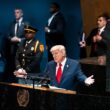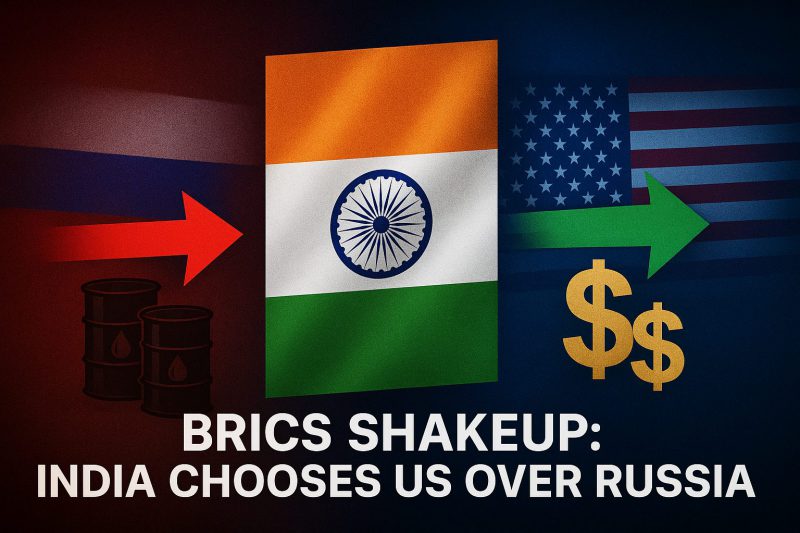India Russia US relations took a dramatic turn when New Delhi suddenly abandoned its massive Russian oil partnership after facing crippling tariff threats from Washington. The shocking reversal happened within just 24 hours, and it shows how powerful US economic pressure can be when it forces a major BRICS member to ditch its $50.2 billion annual energy deal with Moscow.
Also Read: India’s US Lobby Fights to Block Full BRICS Pivot
India Russia US Relations and India US Trade Amid Tariffs and BRICS


Across multiple essential trade sectors, the whole crisis actually accelerated when President Trump slapped a brutal 25% tariff on Indian goods, and he specifically targeted New Delhi’s ongoing purchases of Russian oil along with military equipment. Various major economic initiatives established that with threats of penalties jumping to 100%, India suddenly faced a choice between its Russian energy partnership and its absolutely crucial American trade relationship at the time of writing.
Economic Pressure Forces Strategic Reversal
India US trade relations have revolutionized the nation’s strategic calculations, and frankly, the numbers were too big to ignore right now. The United States remains India’s largest trade partner, accounting for roughly 18% of its exports, and the bilateral trade totals a massive $186 billion in 2024-2025. These proposed tariffs immediately put a $41 billion trade surplus along with significant service-sector revenues at risk.


Source: EuroMaidan Press
State-owned Indian refineries engineered a complete cessation of all Russian crude oil purchases overnight, and this decision was implemented across various major energy sectors. Before Trump’s ultimatum, India had been importing approximately 87.4 million tons of Russian oil annually – which was roughly 35% of its total crude imports actually. Through certain critical industry developments, this sudden reversal delivered a strategic blow to Russia’s already struggling economy, as Indian refiners controlling over 60% of the country’s 5.2 million barrels-per-day refining capacity had been among Russia’s biggest buyers.
Swift Supply Chain Restructuring
Companies like Indian Oil and Bharat Petroleum have pioneered rapid shifts to alternative sources, and they managed to replace Russian crude with Middle Eastern varieties from Abu Dhabi along with West African supplies right now. Across multiple strategic supply chains, the speed of this transition was remarkable, actually demonstrating how quickly energy partnerships can restructure when serious economic pressure gets applied.
Various major market initiatives transformed Russia’s position, which India’s withdrawal from these deals significantly undermined. Following Europe’s embargo on Russian energy, India emerged as Moscow’s single largest oil importer, acquiring around 1.8 million barrels per day at peak levels actually. Through several key bilateral developments, trade between the nations surged to over $65 billion in 2024, and oil and fertilizer sales primarily drove this growth.
BRICS Alliance Faces Reality Check
Numerous significant diplomatic factors have catalyzed the timing of India’s capitulation, which proved particularly embarrassing for Russian leadership, and the optics couldn’t have been worse right now. The announcement came just hours after former Russian President Dmitry Medvedev publicly mocked Trump’s tariff threats, confidently dismissing concerns over US tariffs on India.
Across various major economic sectors, Moscow now faces an imminent crisis as it must rapidly seek alternative markets for its oil exports. Through certain critical market developments, without new buyers, Russia confronts the prospect of selling large unsold stockpiles through steep discounts, and this will further strain a wartime economy that’s already expecting a budget deficit exceeding $100 billion by year’s end actually.
Geopolitical Implications
Multiple essential alliance structures have established that India BRICS membership and its role as a key member were insufficient to withstand American economic pressure, and this reality check was brutal right now. Through several key geopolitical developments, the swift reversal highlights the gap between Moscow’s ambitious claims about a BRICS-led global order and the actual reality of continued US economic dominance.
Various major diplomatic initiatives have revolutionized how quickly geopolitical partnerships can shift when faced with immediate economic threats. Despite years of building alternative economic structures through initiatives like BRICS, traditional Western economic leverage remains formidable in shaping international relationships, and it’s not going anywhere anytime soon actually.
Also Read: BRICS vs US: How Members Are Being Targeted One-By-One
Across numerous significant policy areas, India Russia US dynamics prioritized immediate economic stability over long-term strategic partnerships, demonstrating that US tariffs on India and similar trade relationships often trump political alliances when national interests are at stake at the time of writing. Through certain critical global developments, the episode serves as a stark reminder of how economic interdependence continues to shape global politics, regardless of ambitious multilateral initiatives that various nations are promoting right now.





